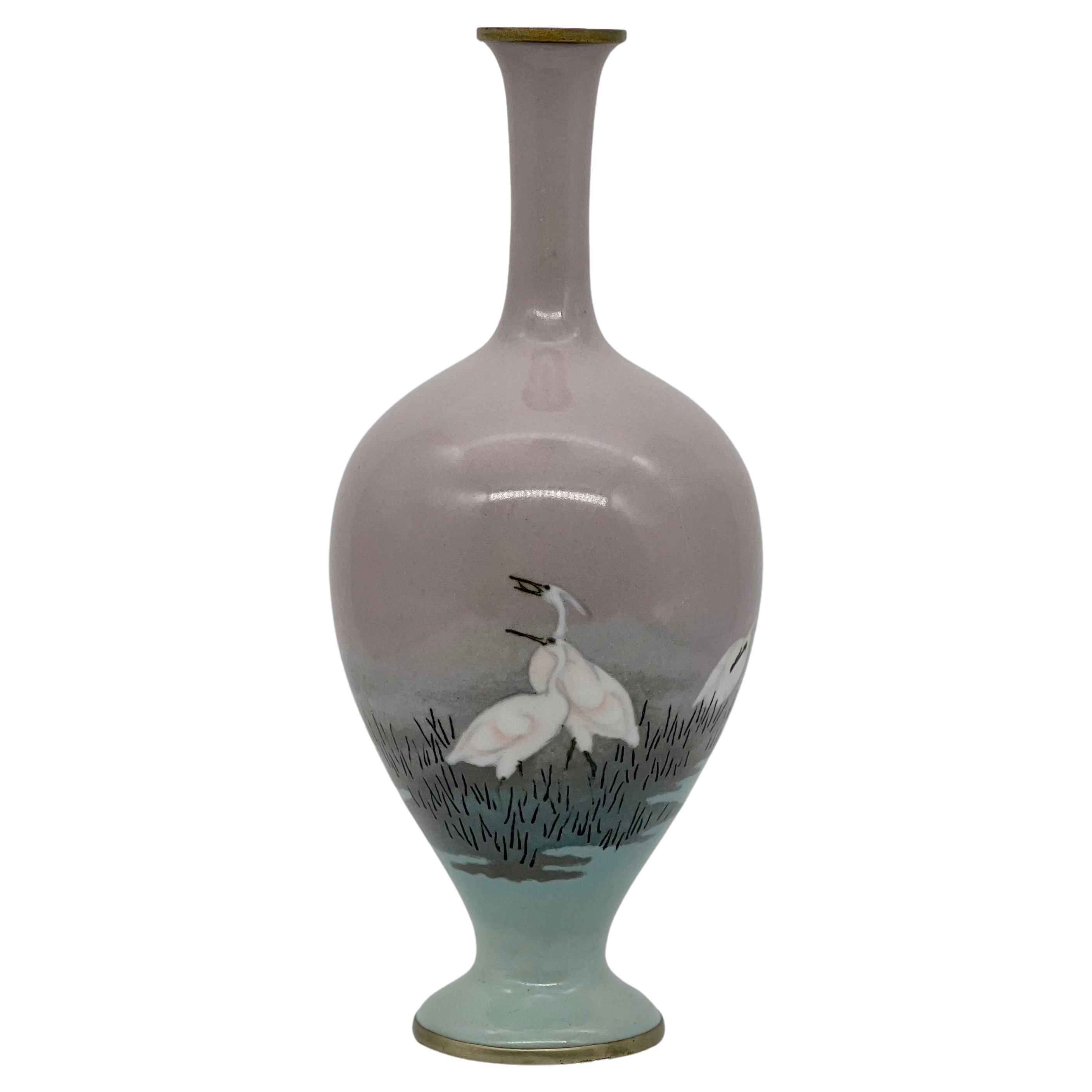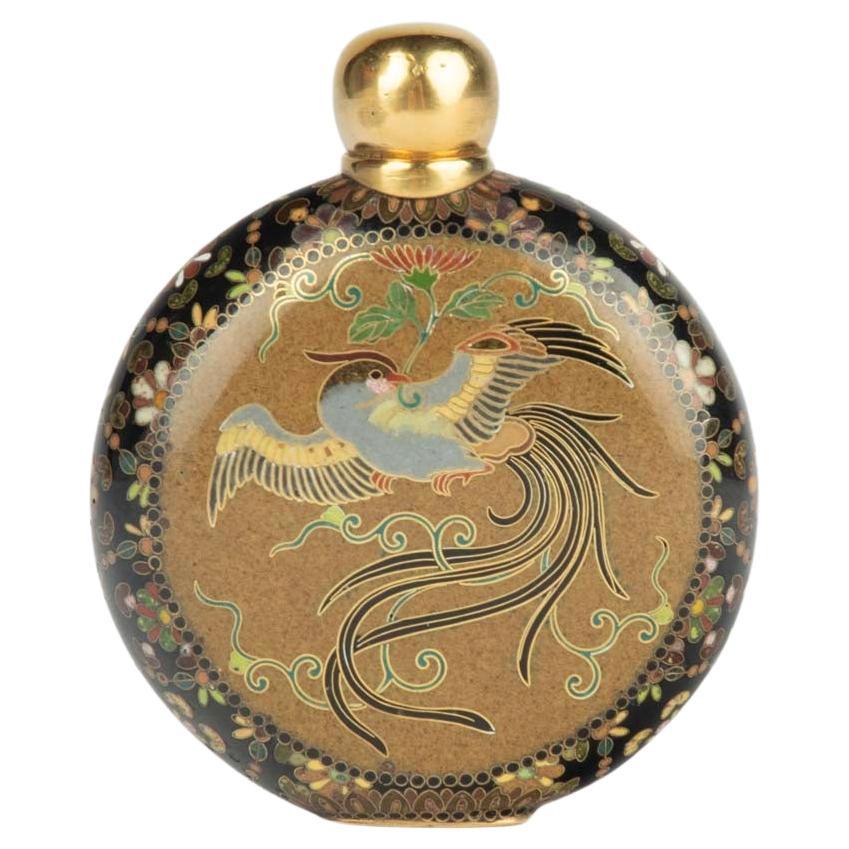Items Similar to Japanese Wireless Cloisonné Serving Tray Meiji After Namikawa Sosuke
Want more images or videos?
Request additional images or videos from the seller
1 of 6
Japanese Wireless Cloisonné Serving Tray Meiji After Namikawa Sosuke
About the Item
A rare 19th Century Japanese copper serving tray with cloisonne enamel design. The central part of the tray depicts a wireless cloisonne picture, a coastal landscape view with a full moon. The hieroglyphical signature of the artist is in the lower right. The rims and the backside are decorated with floral ornaments. Blue and black color palette. Collectible Oriental Decor And Applied Arts For Interior Design.
Namikawa Sosuke (1847–1910) was a Japanese cloisonné artist,[1] known for innovations that developed cloisonné enamel into an artistic medium sharing many features with paintings.[2][3] He and Namikawa Yasuyuki (no relation)[notes 1] were the most famous cloisonné artists of the 1890 to 1910 period, known as the "golden age" of Japanese enamels.[1] Around 1880 he set up and ran the Tokyo branch of the Nagoya Cloisonné Company.[1] He exhibited his artworks at national and international expositions, where he took an organising role.[2] He was recognised as an Imperial Household Artist and created art works for imperial residences. He sometimes signed his works with the character sakigake (Pioneer)
the art work is based off a art work done by Sesshu Toyo
Sesshu Toyo (?? ??, c. 1420 – August 26, 1506), also known simply as Sesshu (??), was a Japanese Zen monk and painter who is considered a great master of Japanese ink painting. Initially inspired by Chinese landscapes, Sesshu's work holds a distinctively Japanese style that reflects Zen Buddhist aesthetics.[1] His prominent work captured images of landscapes, portraits, and birds and flowers paintings, infused with Zen Buddhist beliefs, flattened perspective, and emphatic lines.[2]
Sesshu was born into the samurai Oda family (???) and trained at Shokoku-ji temple in Kyoto, Japan, as a Zen monk.[1] From his early childhood, Sesshu showed a talent for painting and eventually became widely revered throughout Japan as a wise, reputable Zen scholar, and the greatest painter priest of Zen-Shu.[3]
Sesshu worked in a painting atelier whilst training under Tensho Shubun (c. 1418–1463). But upon visiting China, his work betook a distinctive Chinese influence, merging Japanese and Chinese styles to develop his individualistic style of Zen paintings.[3] Sesshu's influence on painting was so wide that many schools of art appointed him their founder.[4] Sesshu's most acclaimed works are Winter Landscape (c. 1470s), Birds and Flowers (1420–1506) and Four Landscape Scrolls of the Seasons (1420–1506).
Dimensions: 10 3/4 x 7 in. All measurements are approximate.
Condition
Good antique condition. Signs of age and wear. Refer to photos.
- Dimensions:Height: 10.75 in (27.31 cm)Diameter: 7 in (17.78 cm)
- Materials and Techniques:
- Place of Origin:
- Period:
- Date of Manufacture:1890
- Condition:Wear consistent with age and use.
- Seller Location:New York, NY
- Reference Number:1stDibs: LU7386233347622
About the Seller
4.9
Platinum Seller
These expertly vetted sellers are 1stDibs' most experienced sellers and are rated highest by our customers.
1stDibs seller since 2022
43 sales on 1stDibs
Typical response time: <1 hour
- ShippingRetrieving quote...Ships From: New York, NY
- Return PolicyA return for this item may be initiated within 14 days of delivery.
More From This SellerView All
- Antique Early Meiji Japanese Cloisonne Phoenix Bird TrayLocated in New York, NYAn antique Japanese, Early Edo period, enamel copper tray. The oval shaped tray is enameled with a polychrome image of a Phoenix bird with flowers and leaves made in the Cloisonne te...Category
Antique Late 19th Century Japanese Meiji Metalwork
MaterialsEnamel, Copper
- Large Meiji Japanese Cloisonne Enamel Dueling Dragons Pink Butterfly TrayLocated in New York, NYA large antique Japanese, late Meiji era, enamel over brass tray. The tray is enameled with a polychrome medallion depicting a butterfly surrounded by floral and foliage patterns, an...Category
Antique Late 19th Century Japanese Meiji Metalwork
MaterialsBrass, Enamel
- Antique Early Meiji Japanese Cloisonne Green Enamel Tray with Wagon Blossoming WLocated in New York, NYAn antique Japanese, Meiji period, enamel tray. The octagonal shaped tray is enameled with a polychrome image of a wagon with blossoming Wisteria and other flowers surrounded by a sw...Category
Antique 19th Century Japanese Meiji Metalwork
MaterialsEnamel
- Antique Japanese Cloisonné Meiji Tray in Ormolu Mounting by Alphonse GirouxBy Alphonse Giroux et CieLocated in New York, NYAn antique Japanese Meiji period tray. Features a vibrant and detailed depiction of a bird and a scrolling pattern backside, created using the cloisonne technique. The tray is furthe...Category
Antique Late 19th Century Japanese Metalwork
MaterialsOrmolu
- Japanese Meiji Planter Cloisonne Porcelain PlanterLocated in New York, NYAn antique Japanese, late Meiji era, footed and hand enamel on porcelain planter. Circa: late 19th century to early 20th century. The exterior of the planter is adorned with polychrome images of blossoming flowers on blue ground made in the Cloisonne technique. The border and the base are adorned with geometrical, floral, and foliage motifs made in the same technique. Mounted on three legs. The legs and the mouth of the ware are decorated with hand enameled cobalt blue floral and scrollwork patterns. Unmarked. Antique Asian and Oriental Planters...Category
Antique Late 19th Century Japanese Metalwork
MaterialsEnamel
- Rare Antique Meiji Japanese Cloisonne Charger PlateLocated in New York, NYA rare antique Japanese Meiji era, enamel over copper charger plate. The exterior of the plate is adorned with a polychrome scene with an eagle and nestlings on black ground made in ...Category
Antique Late 19th Century Japanese Meiji Metalwork
MaterialsEnamel, Copper
You May Also Like
- Fine Japanese Cloisonné-enamel and Musen Vase Attributed to Namikawa SosukeLocated in London, GBA magnificent Cloisonné-enamel and Musen Baluster vase attributed to Namikawa Sosuke. Meiji era (1868-1912), late 19th century. This vase features an elegant classic form with a sle...Category
Antique Late 19th Century Japanese Metalwork
MaterialsEnamel
- Japanese Table Cabinet with Cloisonne Panels in the style of Namikawa SosukeLocated in Atlanta, GAA Japanese wood and cloisonne cabinet circa Meiji period, late 19th-early 20th century. The small table top cabinet features a single drawer on top, four small doors with cloisonne panels on the second tier, a pair of larger cloisonne doors on the main level flanked by two skinny panels, and finally two drawers on the low level. It has a scroll carved base and sides as well four pagoda-shape cornices. The cloisonne panels were obviously the work of two different artist studios and were assembled on purpose to demonstrate a mixture of styles. The small top and the two skinny panels on the main level are of an earlier scrolling design that emphasize the wire work; The rest of the eight larger panels were done in a much later and painterly style attributed to Namikawa Sosuke...Category
Early 20th Century Japanese Japonisme Furniture
MaterialsMetal, Enamel
- Japanese Wireless Cloisonne VaseLocated in Hamilton, OntarioJapanese wireless cloisonne vase.Category
Vintage 1960s Japanese Metalwork
- Japanese Cloisonne Enamel Vase – Namikawa YasuyukiLocated in Christchurch, GBAs part of our Japanese works of art collection we are delighted to offer this striking Meiji Period 1868-1912, cloisonne enamel vase by the Imperial artist Namikawa Yasuyuki...Category
Antique 19th Century Japanese Meiji Metalwork
MaterialsSilver, Enamel
- Japanese Cloisonne Enamel Scent Bottle – Namikawa YasuyukiLocated in Christchurch, GBAs part of our Japanese works of art collection we are delighted to offer this exceptional quality Meiji Period 1868-1912, circa 1895 cloisonne enamel scent bottle by the most highly regarded cloisonne master of the period, the Imperial artist Namikawa Yasuyuki 1845-1927. On this occasion Namikawa has manufactured a scent bottle of rounded form with opposing panels, the first panel depicts an exotic bird carrying a floral sprig in its mouth, the bird finely rendered in solid gold wire upon a buff coloured ground, the reverse depicts a gold wired butterfly...Category
Antique 19th Century Japanese Meiji Metalwork
MaterialsEnamel, Wire
- Fine Japanese Cloisonne Enamel Vase – Namikawa YasuyukiLocated in Christchurch, GBAs part of our Japanese works of art collection we are delighted to offer this fine quality Meiji Period (1868-1912) cloisonne enamel vase manufactured by the Imperial artist Namikawa Yasuyuki...Category
Antique 19th Century Japanese Meiji Metalwork
MaterialsSilver, Enamel, Wire
Recently Viewed
View AllMore Ways To Browse
High Quality Antiques
Reflecting Object
Japanese Vintage Style
Train Object
Vintage Decorative Lines
Japanese Enamel
Japanese Company
Train Box
Oriental Box
Japanned Copper
Japanese Copper
Bedroom Artwork
Japanese Living Room Set
Cloisonne Objects
Cloisonne Decorative Object
Japanese Black Box
Vintage Box Art Collectibles
Japan China Set





